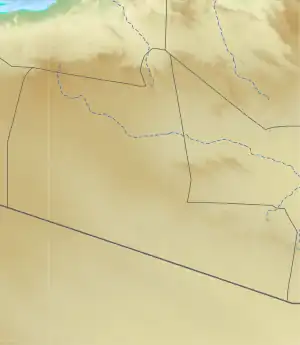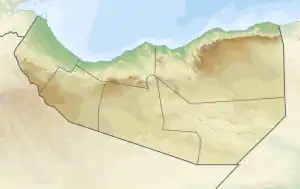Hahi
Xaaxi حاحي | |
|---|---|
Town | |
 Hahi Location in Somaliland  Hahi Hahi (Somaliland) | |
| Coordinates: 09°21′7″N 44°57′51″E / 9.35194°N 44.96417°E | |
| Country | |
| Region | Togdheer |
| District | Oodweyne District |
| Elevation | 1,008 m (3,307 ft) |
| Population (2006)[1] | |
| • Total | 2,971 |
| Time zone | UTC+3 (EAT) |
| Climate | BWh |
Hahi (Somali: Xaaxi, Arabic: حاحي), is a town in Oodweyne District located in western Togdheer, Somaliland.
History
Hahi started as a permanent well for pastoralists and became a settlement. In the 19th century, members of the Sufi order Dandarawiyah would establish a tariqa and jama'a (congregation) at the town. The order was founded by Sayid Mohamed al Dandarawi who was a student of Ibrahim al Rashid and their teachings spread from Arabia to Sudan before eventually reaching Somaliland via the Somali Sheikh Sayid Aadan Ahmed.[2][3] It would spread to Sheikh although it remained much smaller than the established Qadiriyya or Salihiyya orders. A young Nur Ahmed would study in the tariqa of Hahi before a succession crisis would prompt him to leave and eventually see him take the title of Habr Yunis and Reer cali part of arab sub-clan Sultan.[4]
Demographics
In June 2006 Hahi had an estimated population of 2,971.[5] Hahi is inhabited by subclans of the Habar Yoonis Ugaadh Cumar, and reer Cali, a subdivision of the Garhajis and Arap clan of the wider Isaaq clan family.[6]
References
- ↑ "Nutrition assessment - Hawd of Togdheer" (PDF). June 2006. pp. 35–37.
- ↑ Abdurahman M. Abdullahi (Baadiyow) (2015). THE ISLAMIC MOVEMENT IN SOMALIA. Adonis & Abbey. pp. 65–74. ISBN 9781912234035.
- ↑ "Shaykh Sayyid Ibrahim Al-Rashid, www.ahmadiah-idrisiah.com, at-Tariqah al-Ahmadiah al-Idrisiah ar-Rasyidiah ad-Dandarawiah (Singapore)". www.ahmadiah-idrisiah.com. Retrieved 25 March 2023.
- ↑ British Somaliland by Drake Brockman, pages 79–82, 1912.
- ↑ "Nutrition assessment - Hawd of Togdheer" (PDF). June 2006. pp. 35–37.
- ↑ General Survey of the Somaliland Protectorate 1944-1950, 164